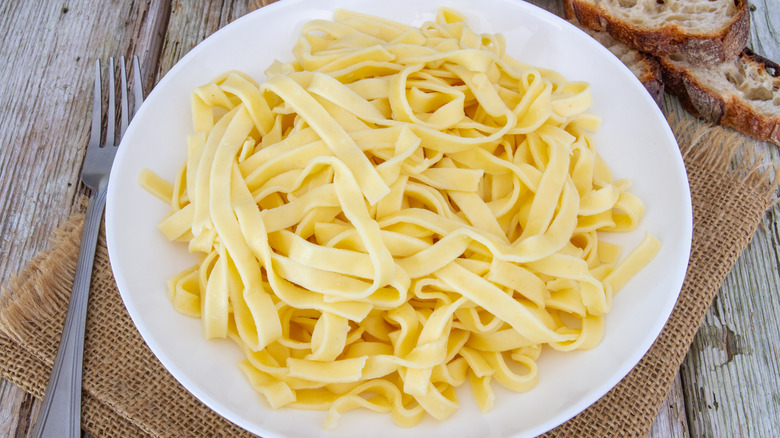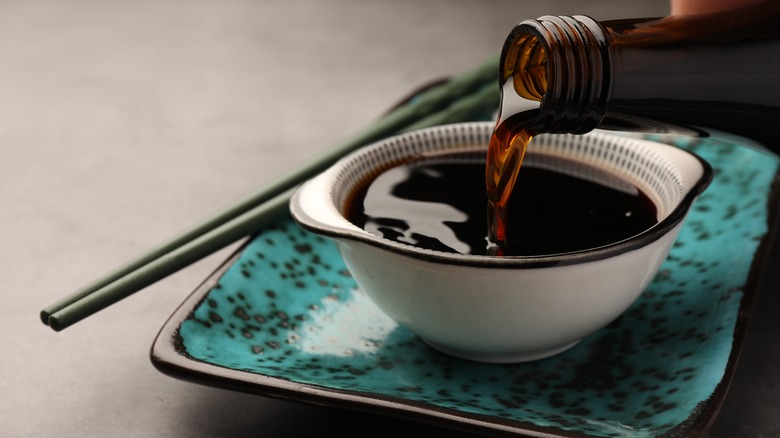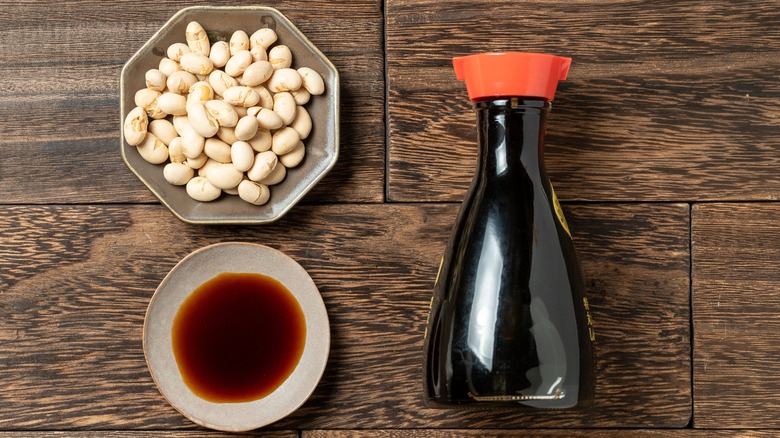This One Ingredient Takes Buttered Noodles To The Next Level
There are few recipes as simple and beloved as buttered noodles. It's enjoyed by all walks of life, from the cliché of picky children to those with food restrictions employing gluten-free noodles and plant-based spreads.
But it can be better. Not just by using the highest-quality ingredients you can find — something that's increasingly important as the amount of ingredients grows smaller — but by adding one extra, special ingredient: soy sauce. This black liquid gold adds a saltiness that helps bring out the flavor of your butter and noodles. Plus, it adds subtle notes of sweetness and umami that make your otherwise plain meal more complex.
However, there are many kinds of soy sauce with origins rooted in several Asian countries. While they all share similar flavors and ingredients, each has its own unique profile that can take your buttered noodles in fascinating directions. And if you ever use too much, add some lemon to tone down your soy sauce's impact and give your noodles some zing.
How Chinese, Japanese, and Korean soy sauces affect buttered noodles
Chinese soy sauces typically come in light and dark varieties, so named because the sauces have lighter and darker coloration and intensity of flavor. Lighter sauces are perfect for adding a hint of saltiness and sweetness to noodles you otherwise want to keep focused on the butter. Dark sauces, especially ones with molasses added, are much sweeter and not as salty. They can also make your noodles wonderfully browned, especially if you use browned butter for nutty notes.
Japanese soy sauces also come in light and dark forms with similar differences, but as a whole have a bit more umami and sweetness with slightly less salt than Chinese sauces. Use light sauces if you want a perfect balance of salty, sweet, and umami that doesn't overpower. Darker sauces give you deeper, richer flavor, especially more umami.
Korean soy sauces, called ganjang, are similarly salty to Chinese sauces but use more soybeans, giving them an earthier flavor. They also come in two main varieties that are analogous to the light and dark of China and Japan. Kook-ganjang, or soup soy sauce because it's typically used to flavor soup, would give your noodles a mildly salty and umami undertone. Jin-ganjang, or fermented soy sauce, would load your noodles up with a deep, nuanced umami that comes from its mushroom-or-bacteria-based fermentation stage.
How Taiwanese, Filipino, and Indonesian soy sauces affect buttered noodles
There are plenty of other soy sauce varieties that are in line with Chinese and Japanese soy sauce influences. But, some more unique options are also available for your buttered noodles. Certain Taiwanese sauces use black soybeans instead of the more commonly used yellow varieties, for example, which some think gives the soy sauce, and your noodles, a richer mouthfeel.
Filipino soy sauce, also called toyo, has some of the strongest, richest flavors you can get. It's also fairly thin, making it one of the easiest soy sauces to mix in with your noodles. Like dark Chinese sauces, toyo can sometimes add sweeteners, though this sweetness is mild compared to its saltiness and tang. It's perfect if you want the butter flavor of your noodles to come second to the soy sauce upgrade.
Indonesian soy sauce, called kecap manis, toes the line on being a soy sauce or being its own unique recipe. Unlike the other sauces, kecap manis is typically thick, gooey, and sweet because of palm sugar, one of its key ingredients. Some kecap manis can also include extra spices to further push its flavor away from soy. Because of its strong, unique flavors and its syrup-like consistency, it's best to use it as a finishing drizzle for your buttered noodles.


